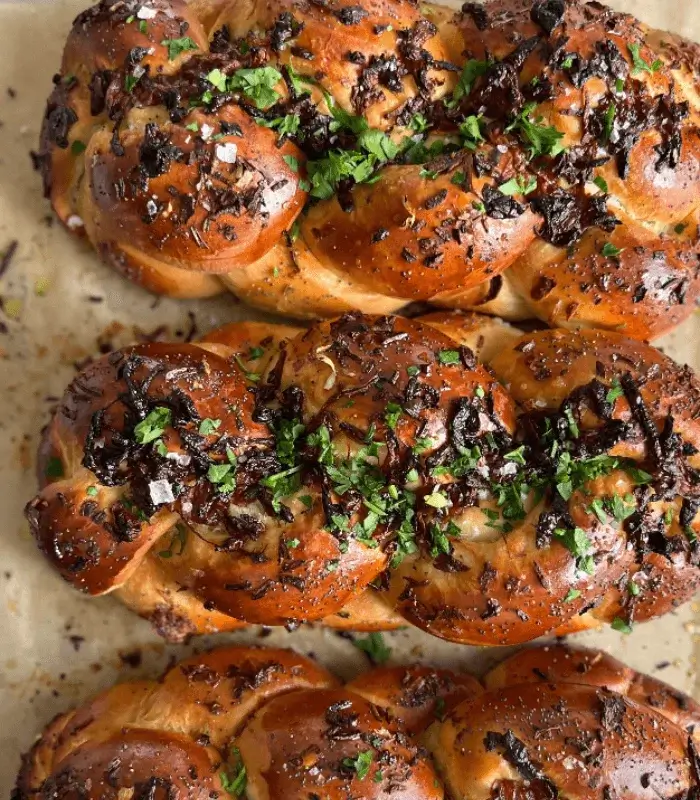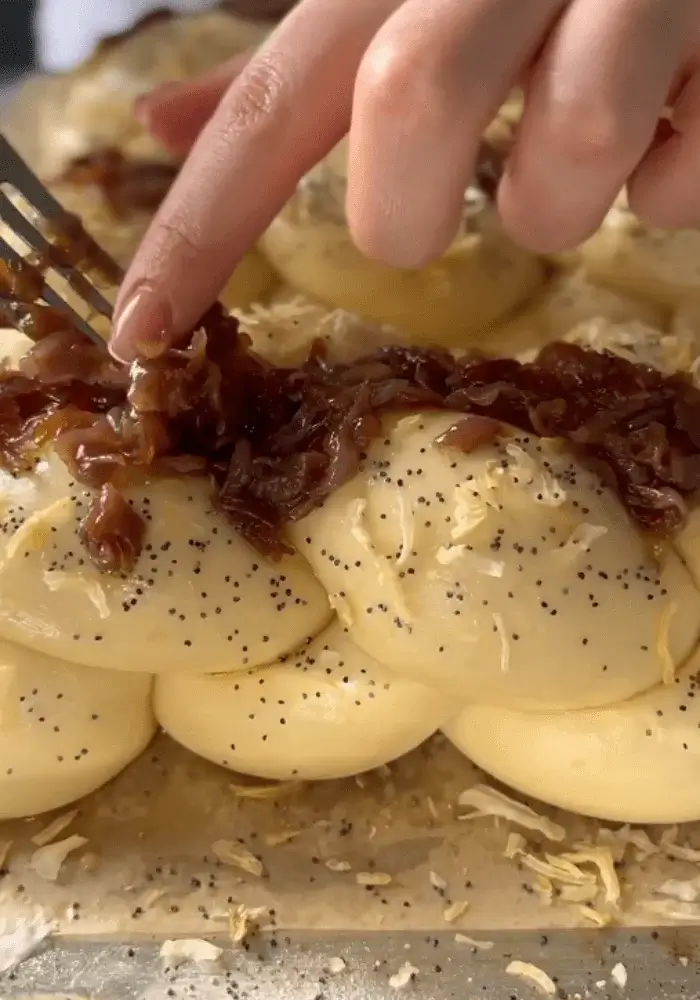Four Braided Challah with Caramelized Onions and Herb Topping
We may earn a commission from recommended products, at no extra cost to you. See Disclosure.
- Baking sheet
INGREDIENTS
- 2.2 pounds/1 kilogram all-purpose flour
- 1.4 ounces/40 grams fresh yeast or 0.7 ounces/20 grams active dry yeast
- ½ cup/100 grams sugar
- ¾ cup/180 milliliters oil
- 2 cups/500 milliliters lukewarm water
- 1 tablespoon kosher salt
Toppings:
- 1 egg, beaten
- 2 large red onions, peeled and julienned
- 2 to 3 tablespoons olive oil, for frying
- 2 tablespoons poppy seeds
- 2 tablespoons onion flakes
- 1 tablespoon flake sea salt
- ½ cup fresh parsley leaves, chopped
INSTRUCTIONS
- In the bowl of a stand mixer fitted with the dough hook, combine the flour, yeast, and sugar. Mix on low speed for 1 minute to blend. With the mixer running, slowly pour in the canola oil and lukewarm water. Once the dough begins to come together, add the salt. Increase the speed to medium-low and knead for at least 10 minutes, until the dough is smooth and elastic. If kneading by hand, use a large mixing bowl and work the dough on a floured surface until it passes the windowpane test.
- Transfer the dough to a large greased mixing bowl, cover with plastic wrap or a clean kitchen towel, and let rise at room temperature until doubled in volume, about 1 hour.
- Heat the olive oil in a wide skillet over medium-low heat. Add the onions and a pinch of salt. Cook, stirring often, for 25 to 30 minutes, until the onions are soft, deeply golden, and fragrant. Reduce the heat if they begin to brown too quickly. Remove from the heat and let cool.
- Preheat the oven to 350°F (175°C), using the convection setting if available.
- Punch down the dough to deflate it and transfer to a clean work surface. Divide into 2 or 3 equal portions. For each loaf, divide the dough into 4 equal strands and braid into a four braided challah. For added flavor, gently fold some of the caramelized onions into the dough before shaping, or reserve them for topping.
- Place the shaped loaves on a parchment-lined sheet pan. Cover loosely and let rise again for 30 minutes, until slightly puffed.
- Brush the loaves evenly with the beaten egg. Top with poppy seeds, onion flakes, and caramelized onions, pressing gently so the toppings adhere. Bake for 25 to 30 minutes, until the challahs are deep golden brown. Check the bottom—when tapped, it should sound hollow and appear golden, not pale.
- Cool on a wire rack for at least 30 minutes. Sprinkle with flake sea salt and parsley.
RECIPE NOTES

FAQ
Best flour for this four braided challah
The best flour to use is high-protein all-purpose flour or bread flour. These flours typically contain around 11–13% protein, which helps develop a strong gluten network essential for achieving a soft yet structured crumb. The gluten allows the dough to rise well and retain air, resulting in a fluffy interior. If the flour has too little protein, the challah may collapse or have a dense texture. Stick with unbleached flour, as bleached versions may produce inconsistent results. You can also combine bread flour and all-purpose flour to balance strength with tenderness.

How do I properly braid the challah?
First ensure that the dough strands are of equal length and thickness. Start by pinching the ends of all four strands together at one end, then follow a consistent pattern: bring the far right strand over the two middle strands, then place the second from the left under the middle strand. Repeat this sequence while keeping even tension. When finished, pinch the bottom ends together and tuck both ends slightly underneath. Let the braided dough rise again before baking to help set the shape. This technique prevents the strands from unraveling or shifting in the oven.
Can I make this four braided challah dough in advance?
After kneading, place the dough in a lightly greased bowl, cover it tightly with plastic wrap, and refrigerate for up to 18 hours. The cold fermentation allows for more complex flavor development. When ready to use, remove the dough from the fridge and let it come to room temperature, which can take 1 to 2 hours. Proceed with dividing, braiding, and proofing as normal. The dough may require slightly longer final proofing time since it starts cold, but the result will still be light and flavorful.

Can I use whole wheat flour in this four braided challah recipe?
You can substitute part of the flour in a four braided challah recipe with whole wheat flour, but it will affect both texture and flavor. Whole wheat flour contains more bran and germ, which can make the dough denser and reduce rise due to interference with gluten development. To maintain a soft crumb, use a 50/50 mix of whole wheat and bread or all-purpose flour. You may also need to increase the hydration slightly, as whole wheat absorbs more liquid. The flavor will be nuttier and more robust, which pairs well with savory toppings like caramelized onions or nigella seeds.
How can I prevent the challah from becoming too dry during baking?
First ensure proper dough hydration—don’t reduce the water content below what the recipe calls for. Overbaking is a common issue; start checking doneness at the minimum recommended time. The challah is ready when it’s deeply golden and sounds hollow when tapped on the bottom. Use an oven thermometer to confirm that your oven maintains a consistent 350°F (175°C). Brushing the dough with egg wash helps retain moisture and creates a glossy crust. If you plan to store it, wrap the bread tightly in foil or plastic wrap once cooled to preserve softness.
Is it possible to freeze four braided challah after baking?
Once completely cooled, wrap the loaf tightly in plastic wrap and then in aluminum foil or place in a freezer-safe bag. Label and date it; the bread will keep for up to 2 months. To reheat, remove the foil and thaw at room temperature for 1 to 2 hours while still wrapped in plastic. For best texture, warm it in a 250°F (120°C) oven for 10 to 15 minutes, either wrapped in foil for a softer crust or uncovered for a crispier exterior. This restores its fresh-baked flavor and texture effectively.

